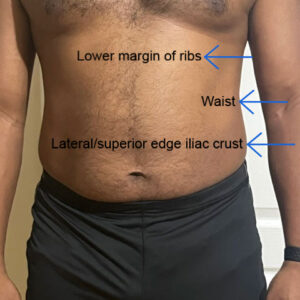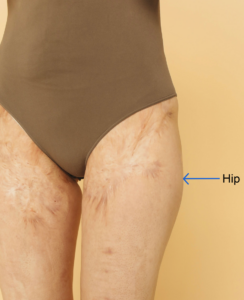Main Body
Other Anthropometric Body Measurement Assessments
There are several other anthropometric body measurements used in healthcare settings. In this section, three additional measurements are discussed including:
- Waist and hip circumference.
- Waist-to-hip ratio.
- Waist-to-height ratio.
These measurements provide data related to central adiposity. Some research has suggested these body measurements are better predictors of certain diseases (such as diabetes) in comparison to BMI measurements (Mirzaei & Khajeh, 2018).
A vinyl, flexible, non-stretch tape measure should be used to assess waist and hip circumference. Its flexible nature allows for accuracy and the vinyl composition allows for cleaning after use. For both waist and hip circumference, discuss with the client that their waist and hip will need to be clear of any clothing. It is best to perform measurements on bare skin. You should stand at the client’s side and ask them to stand with arms hanging down at their side.
Waist circumference
Waist circumference refers to the distance around the waist. This measurement is used as an indicator of health risk based on excess adipose tissue around the waist (Health Canada, 2003). Although not currently used as common in practice as BMI, it has been found that waist circumference may be a better marker of health risk because of its focus on central adiposity around the abdomen (Ross et al., 2020). It is suggested that waist circumference provides information about the quantity of fat surrounding the body’s main organs (e.g., heart, liver, kidneys). However, it is suggested that BMI and waist circumference measurements together (as opposed to alone) are a better approach in measuring obesity (Ross et al., 2020). Bosomworth (2019) indicates that a measurement that reflects central obesity is a better indicator of disease and mortality than BMI, and that a combination of the two is best.
Steps in measuring waist circumference include:
- Wrap the tape measure around the waist so that it is placed halfway between the lower margin of the ribs (at the mid-axillary line) and the lateral/superior edge of the iliac crest (the outside and top of the ilium). See Figure 4. This is the most common protocol, but keep in mind that it varies across and within institutions and countries. If your institution doesn’t have a protocol, document your measurement location.
- Ensure the tape measure lays flat around the waist and parallel to the floor (it should be snug around the waist, but doesn’t compress the skin).
- Ask the client to take two or three normal breaths and measure the waist just after the client breathes out when they are relaxed.
- It is best to repeat the process twice to confirm accuracy.
The guidelines indicate that there is increased risk of developing health problems when the waist circumference is greater than or equal to 102 centimetres (40 inches) in men and greater than or equal to 88 centimetres (35 inches) in women (Adapted from WHO, Health Canada, 2003). However, Obesity Canada (Rueda-Clausen et al., 2020) has proposed waist circumference cut-off points to take into consideration ethnicities. For additional information check out (pg. 5): this link

Figure 4: Waist circumference location
Waist-to-hip ratio
The waist-to-hip ratio refers to waist circumference divided by hip circumference (Andreacchi et al., 2021).
Steps in measuring waist-to-hip ratio include:
- Measure the waist circumference (as previously described)
- Wrap the tape measure around the hips so that it is aligned at what is typically referred to as the widest portion of the buttocks and hips (Andreacchi et al., 2021). See Figure 5.
- Then, you follow this formula: waist circumference divided by the hip circumference. For example, if the waist circumference is 76 centimetres and the hip circumference is 91 centimetres, the waist-to-hip ratio is: .84
The WHO (2008) guidelines indicate that increased risk is associated with waist-to-hip ratios of greater than or equal to .90 centimetres in men and greater than or equal to .85 centimetres.

Figure 5: Hip circumference location
Waist-to-height ratio
The waist-to-height ratio is a measurement of central adiposity (Yoo, 2016). The formula is: waist circumference divided by height.
Steps in measuring waist-to-height ratio include:
- Measure the waist circumference (as previously described) and measure the height (as detailed earlier).
- Then, you follow this formula: waist circumference divided by the height. For example, if if the waist circumference is 76 centimetres and the height is 162 centimetres, the waist-to-height ratio is: .47
It is suggested that a waist-to-height ratio of .5 or higher means the client may have an increased risk for certain diseases. The optimal waist-to-height ratio is based on the belief that the client’s waist measurement should be less than half their height.
Contextualizing Inclusivity
It is best to use a trauma-informed approach when taking these measurements. For example, place the tape measure at the side of the waist/hips and ask the client to hold it momentarily while you walk around them and wrap the tape measure around the waist/hips. This approach is less intrusive than reaching up and around the client to place the tape measure around them.
Knowledge Bites
There is research on how fat distribution varies across individuals from different cultural backgrounds. Wagner and Heyward (2000) note that many individuals who are Black and/or of African descent show patterns of carrying more adipose tissue on the body’s trunk than the legs. Thus, waist circumferences could be affected.
Clinical Tips
You should inquire about food/fluid intake, constipation or gas, and any swelling on the day of measurements because the amount of fluid/water, gas, and edema can affect waist measurements.
Activity: Check Your Understanding
References
Andreacchi, A., Griffith, L., Emmanuel, G., Mayhew, A., Bassim, C., Pigeyre, M., Stranges, S., & Anderson, L. (2021). Body mass index, waist circumference, waist-to-hip ratio, and body fat in relation to health care use in the Canadian Longitudinal Study of Aging. International Journal of Obesity, 45, 666-676.
Bosomworth, J. (2019). Normal-weight central obesity: Unique hazard of the toxic waist. CMAJ, 65(6), 399-408.
Health Canada (2003). Canadian Guidelines for Body Weight Classification in Adults: Quick Reference Tool for Professionals. https://www.canada.ca/content/dam/hc-sc/migration/hc-sc/fn-an/alt_formats/hpfb-dgpsa/pdf/nutrition/cg_quick_ref-ldc_rapide_ref-eng.pdf
Mirzaei, M., & Khajeh, M. (2018). Comparison of anthropometric indices (body mass index, waist circumference, waist to hip ratio and waist to height ratio) in predicting risk of type II diabetes in the population of Yazd, Iran. Diabetes & Metabolic Syndrome: Clinical Research & Reviews, 12(5), 677-682. https://doi.org/10.1016/j.dsx.2018.04.026
Rueda-Clausen, C., Poddar, M., Lear, S., Poirier, P., & Sharma, A. Canadian Adult Obesity Clinical Practice Guidelines: Assessment of People Living with Obesity. Obesity Canada. https://obesitycanada.ca/wp-content/uploads/2021/05/6-Obesity-Assessment-v6-with-links.pdf
Wagner, D., & Heyward, V. (2000). Measures of body composition in blacks and whites: A comparative review. Am J Clin Nutr, 71(6), 1392-1402. https://doi.org/10.1093/ajcn/71.6.1392
World Health Organization (2008). Waist circumference and waist-hip ratio: Report of a WHO expert consultation. https://www.who.int/publications/i/item/9789241501491
Yoo, E. (2016). Waist-to-height ratio as a screening tool for obesity and cardiometabolic risk. Korean J Pediatr, 59(11), 425-431. https://doi.org/10.3345/kjp.2016.59.11.425

